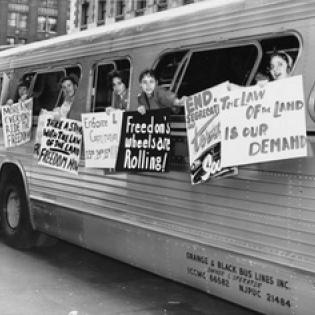Put Your Hands in Mine
In this lesson, we explore the role of youth in the advancement of human and civil rights. Young people share ideas about how they can promote the common good and lead positive social changes.
The learner will:
- describe the role of young people as agents of change
- define the terms: advocacy, philanthropy, civil rights, and justice
- identify ways to be an agent of change related to issues they care about.
- video and articles about the 1963 Children's March in Birmingham
- information about the March for Our Lives student movement for gun control after a school shooting in Parkland, Florida
What is one change you can make in your home or classroom without the permission of an adult?
DVD Mighty Times: The Children's March https://www.learningforjustice.org/classroom-resources/film-kits/mighty-times-the-childrens-march
Instructions
Anticipatory Set:
When we look at events in history, we see many acts of injustice (killing of the Jews in WWII, oppression of African Americans in the U.S., inability for women to vote, hate crimes, and persecution of religious groups). Many of these injustices were stopped because people and groups took voluntary action to demand change for themselves or for the sake of others. Talk about examples of people taking action to demand justice.
Define change in the context of making a better community: Change is doing things differently either because what was happening wasn't working anymore or not working effectively enough to meet the desired results. Discuss why people participate in actions to make change.
Discuss the terms justice and human rights.
Read about or watch the video about the Children's March in 1963 Birmingham: The Mighty Times: The Children's March. School-age children participated in non-violent demonstrations for racial justice and a demand to end segregation.
Read and watch coverage of the March for Our Lives movement in which young people demanded gun control laws after the 2018 mass shooting at a school in Parkland Florida.
Describe their action as advocacy, or using their voice to speak up about an issue. Advocacy is a form of philanthropy, which it using one's time, talent, or treasure for the common good.
Have the learners think about ways that they can be agents of change for the common good. They don't have to think of big global change. It can be small changes like healthy lunches or inclusive practices at local events.
Use a decision-making model to choose a change they would like to work toward through advocacy.
Make a plan of action and carry out a plan to make a change to improve the classroom, community, or world.
Philanthropy Framework
-
Strand PHIL.I Definitions of Philanthropy
-
Standard DP 01. Define Philanthropy
-
Benchmark MS.1 Define philanthropy as individuals and organizations providing their time, talent, and/or treasures intended for the common good throughout history and around the world. Give examples.
-
Benchmark MS.4 Give examples of how individuals have helped others.
-
-
-
Strand PHIL.II Philanthropy and Civil Society
-
Standard PCS 01. Self, citizenship, and society
-
Benchmark MS.4 Describe the characteristics of someone who helps others.
-
Benchmark MS.5 Identify historic examples of citizens using civil society organizations to petition the government.
-
-
Standard PCS 02. Diverse Cultures
-
Benchmark MS.2 Describe the importance of hearing all voices in a community and respecting their right to be heard.
-
Benchmark MS.5 Discuss examples of groups denied their rights in history.
-
Benchmark MS.7 Identify women and minorities who are or have been leaders in the civil society sector.
-
-
Standard PCS 05. Philanthropy and Government
-
Benchmark MS.10 Give historic and contemporary examples of a voluntary action by an individual or a private organization that has helped to enhance a fundamental democratic principle.
-
Benchmark MS.12 Identify the dilemma of minority rights in a pure democracy.
-
-
Standard PCS 06. Philanthropy in History
-
Benchmark MS.1 Explain the role of philanthropy in major themes and social issues in the nation's history.
-
Benchmark MS.2 Give an example of individual philanthropic action that influenced the nation's history.
-
Benchmark MS.5 Identify positive philanthropic historic acts or events that helped build the community, state, and nation.
-
-
-
Strand PHIL.III Philanthropy and the Individual
-
Standard PI 01. Reasons for Individual Philanthropy
-
Benchmark MS.10 Identify reasons why historic figures acted for the common good.
-
Benchmark MS.4 Identify and describe the actions of how citizens act for the common good.
-
Benchmark MS.5 Describe the responsibility students have to act in the civil society sector to improve the common good.
-
-
-
Strand PHIL.IV Volunteering and Service
-
Standard VS 01. Needs Assessment
-
Benchmark MS.1 Identify a need in the school, local community, state, nation, or world.
-
-
